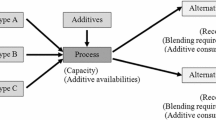Abstract
In the past few years, the mining industry has seen a lot of operational changes. Digitalization and automation of many processes have paved the way for an increase in its general productivity. In keeping with this trend, this article presents a novel approach for optimizing underground mine scheduling for the short- and medium-term. This problem is similar to the Resource-Constrained Project Scheduling Problem, with the difference that all task completions are optional. The model uses Constraint Programming principles to maximize the Net Present Value of a mining project. It plans work shifts for up to a year in advance, considering specialized equipment, rock support and operational constraints. This is the first published paper using optional variables to model optional tasks in a real-life application. Results from its applications to datasets based on a Canadian gold mine demonstrate its ability to find optimal solutions in a reasonable time. A comparison with an equivalent Mixed Integer Programing model proves that the Constraint Programming approach offers clear gains in terms of computability and readability of the constraints.


Similar content being viewed by others
References
Artigues, C. (2017). On the strength of time-indexed formulations for the resource-constrained project scheduling problem. Operations Research Letters, 45(2), 154–159.
Astrand, M., Johansson, M., & Zanarini, A. (2018). Fleet scheduling in underground mines using constraint programming. In International conference on the integration of constraint programming, artificial intelligence, and operations research (Vol. 10848 pp. 605–613). https://doi.org/10.1007/978-3-319-93031-2
Bienstock, D., & Zuckerberg, M. (2010). Solving LP relaxations of large-scale precedence constrained problems, pp. 1–14, Springer.
Bjørndal, T., Herrero, I., Newman, A., Romero, C., & Weintraub, A. (2012). Operations research in the natural resource industry. International Transactions in Operational Research, 19(1-2), 39–62. https://doi.org/10.1111/j.1475-3995.2011.00800.x
Bley, A., & Terblanche, S.F. (2015). An improved formulation of the underground mine scheduling optimization problem when considering selective mining. Optimization Online, 31(1), 1–16. https://doi.org/10.5784/31-1-422
Campeau, L.P., Gamache, M., & Martinelli, R. (2022). Integrated optimisation of short-and medium-term planning in underground mines. International Journal of Mining, Reclamation and Environment, 36(4), 235–253.
Campeau, L.P., & Michel, G. (2020). Short-term planning optimization model for underground mines. Computer & Operations Research, 115, 104642.
Carpentier, S., Gamache, M., & Dimitrakopoulos, R. (2016). Underground long-term mine production scheduling with integrated geological risk management. Mining Technology, 125 (2), 93–102. https://doi.org/10.1179/1743286315Y.0000000026
Epstein, R., Goic, M., Weintraub, A., Catalán, J., Santibáñez, P., Urrutia, R., Cancino, R., Gaete, S., Aguayo, A., & Caro, F. (2012). Optimizing long-term production plans in underground and open-pit copper mines. Operations Research, 60(1), 4–17. https://doi.org/10.1287/opre.1110.1003
Schutt, A., Chu, G., Stuckey, P. J., & Wallace, M. G. (2012). Maximising the net present value for resource-constrained project scheduling. International Conference on Integration of Artificial Intelligence (AI) and Operations Research (OR) Techniques in Constraint Programming, pp. 362–378. Springer.
Hartmann, S., & Briskorn, D. (2010). A survey of variants and extensions of the resource-constrained project scheduling problem. European Journal of Operational Research, 207(1), 1–14. https://doi.org/10.1016/j.ejor.2009.11.005
Martinelli, R., Collard, J., & Gamache, M. (2020). Strategic planning of an underground mine with variable cut-off grades. Optimization and Engineering, 21(3), 803–849. Springer.
Kreter, S., Schutt, A., & Stuckey, P.J. (2017). Using constraint programming for solving RCPSP/max-cal. Constraints, 22(3), 432–462. https://doi.org/10.1007/s10601-016-9266-6
Laborie, P., Rogerie, J., Shaw, P., & Vilím, P. (2018). IBM ILOG CP optimizer for scheduling: 20+ years of scheduling with constraints at IBM/ILOG. Constraints, 23(2), 210–250. https://doi.org/10.1007/s10601-018-9281-x
Little, J., Knights, P., & Topal, E. (2013). Integrated optimization of underground mine design and scheduling. Journal of the Southern African Institute of Mining and Metallurgy, 113(10), 775–785.
Lustig, I.J., & Puget, J.F. (2001). Program does not equal program: Constraint programming and its relationship to mathematical programming. Interfaces, 31(6), 29–53.
Martinelli, R., Collard, J., & Gamache, M. (2020). Strategic planning of an underground mine with variable cut-off grades. Optimization and Engineering 21(3), pp. 803–849. Springer.
Martinez, M.A., & Newman, A.M. (2011). A solution approach for optimizing long- and short-term production scheduling at LKAB’s Kiruna mine. European Journal of Operational Research, 211(1), 184–197. https://doi.org/10.1016/j.ejor.2010.12.008
Montiel, L., Dimitrakopoulos, R., & Kawahata, K. (2016). Globally optimising open-pit and underground mining operations under geological uncertainty. Mining Technology, 125(1), 2–14. https://doi.org/10.1179/1743286315Y.0000000027
Muñoz, G., Espinoza, D., Goycoolea, M., Moreno, E., Queyranne, M., & Letelier, O.R. (2018). A study of the Bienstock–Zuckerberg algorithm: applications in mining and resource constrained project scheduling Vol. 69. Springer. https://doi.org/10.1007/s10589-017-9946-1
Musingwini, C. (2016). Presidential address: Optimization in underground mine planning-developments and opportunities. Journal of the Southern African Institute of Mining and Metallurgy. https://doi.org/10.17159/2411-9717/2016/v116n9a1
Nehring, M., Topal, E., Kizil, M., & Knights, P. (2012). Integrated short- and medium-term underground mine production scheduling. Journal of the Southern African Institute of Mining and Metallurgy, 112(5), 365–378.
Newman, A.M., Rubio, E., Caro, R., Weintraub, A., & Eurek, K. (2010). A review of operations research in mine planning. Interfaces, 40 (3), 222–245. https://doi.org/10.1287/inte.1090.0492
O’Sullivan, D., & Newman, A. (2015). Optimization-based heuristics for underground mine scheduling. European Journal of Operational Research, 241(1), 248–259. https://doi.org/10.1016/j.ejor.2014.08.020
O’Sullivan, D., Brickey, A., & Newman, A. (2015). Is open pit production scheduling ’easier’ than its underground counterpart? Mining Engineering, 67(4), 68–73.
Torres, V.F.N., Nader, B., Ortiz, C.E.A., Souza, F.R., Burgarelli, H.R., Soares chaves, L., Carvalho, L.A., Renata Câmara, T., Zanetti, E., & Galery, R. (2018). Classical and stochastic mine planning techniques, state of the art and trends. Mining, 71(2), 289–297.
Author information
Authors and Affiliations
Corresponding author
Additional information
Publisher’s note
Springer Nature remains neutral with regard to jurisdictional claims in published maps and institutional affiliations.
This research was funded with the Discovery Grant no. RGPIN-06402-2016 from The Natural Sciences and Engineering Research Council of Canada (NSERC)
Rights and permissions
Springer Nature or its licensor holds exclusive rights to this article under a publishing agreement with the author(s) or other rightsholder(s); author self-archiving of the accepted manuscript version of this article is solely governed by the terms of such publishing agreement and applicable law.
About this article
Cite this article
Campeau, LP., Gamache, M. Short- and medium-term optimization of underground mine planning using constraint programming. Constraints 27, 414–431 (2022). https://doi.org/10.1007/s10601-022-09337-w
Accepted:
Published:
Issue Date:
DOI: https://doi.org/10.1007/s10601-022-09337-w




